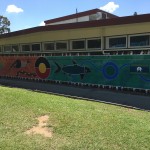What it takes to get over the QCE finish line for our Aboriginal and Torres Strait Islander Students
In 2017, our Indigenous students are attaining their QCE at far higher rates than have in the past. With attainment rates at an all time high of 97.2% in parts of SE QLD, Indigenous students are graduating from Senior Schooling with more opportunity than those who have come before them. So what are the essential ingredients required to ensure their success? What are the barriers that limit their achievement and how can we ensure that those that do attain a QCE, go on to fulfil their potential.
Historically, the majority of Aboriginal and Torres Strait Islander children were never afforded a high level of education. Many Elders I have worked with over the past 20 years have shared that the Government policy and practice of the day reflected that of Social Darwinism. These Governments held a belief that meant many of our Elders were not educated past a Year 3 standard of education and were simply educated to be trained up as domestics or servants. At the age of 14, they would be sent to the many homesteads and properties throughout Queensland to act as slaves for the white station owners. Their employment was facilitated by the Government in response to ads placed in the Queensland Country Life magazine.
The next generation faced similar disadvantage. Up until the early 70’s, a State High School Principal could deny an education to an Indigenous student on account of their Aboriginality or Torres Strait Islander heritage. If they were accepted, many faced prejudice by educators who still carried this post colonial hangovers and in turn they struggled to reach their potential within this culturally unsafe environment.



Marsden SHS
Having recently travelled the state reviewing State schools, Independent Public Schools and Private schools, I was privileged to see, hear and feel what is and isn’t working well to support our Indigenous kids to attain a QCE. It’s not rocket science, but rather a blend of many different elements. In no particular order, here are the top 10 things you can do in your school to support Indigenous success and achievement.
- A team approach – a school that has both Indigenous Education Workers (CEC’s) and non-Indigenous staff (Executive level) leading and supporting the Indigenous education improvement agenda ensures success.
- An Indigenous community – Parents, families, Elders, Indigenous Health services, programs like Deadly Choices, ARTIE, Clontarf Academy, AIME, Beyond Broncos, Cowboys, Girls Academy and many local grass roots initiatives, whom together, are all focused on better outcomes in not only attainment, attendance and retention, but the health and well-being of our future leaders.
- Cultural space – providing a space or room for our students to be supported within ensures that they don’t slip between the cracks and heightens their accountability and visibility. It also provides a space that community and Elders will feel safe to connect with and in turn ensure meaningful collaborative partnerships are supported. This can also enable the exploration of curriculum opportunities to embed the local story. Remembering that murals, signs in language, yarning circles, art installations, flags and Acknowledgement of Country signs all imperative when building a culturally safe environment.
- Access to technology – with the laptop levy being fazed out and Bring your own device (BYOD) common practice in many schools, a lot of our students don’t have home internet or access to a learning device to support them to complete assessments. Technology and computers are the lead pencils of today. Without them, engagement and attainment is severely impacted upon and creates a barrier to learning.
- Financial support – School fees, resource hire, uniforms, shoes, excursions, incursions, VET subject fees are huge financial pressures for large families. Again, without access to these opportunities within our Education systems, many students are forced to make subject selections based on cost rather than interest. This often results in truancy , poor attendance and low levels of self efficacy; key ingredients for disengagement. There are many Indigenous scholarships available to support Senior students, however, we must build our students levels of attainment and attendance earlier in Year 10 in order to support them to build their eligibility. Term 3 presents a great time to plan for the following year and discuss what budgeting may be required for the year ahead, building on what has occured.
- Curriculum – how well a school embeds Aboriginal and Torres Strait Islander cultures and history within the Australian curriculum is the emerging space, but a necessary one. Most schools in general are not doing this well and I often hear educators say, “I wasn’t taught this in school!”. Statements like these are no excuse to not pursue building your professional capability. The Australian Professional Standards for Teachers 1.4 and 2.4 are Indigenous specific and are non negotiable. We must encourage our colleagues to build their cultural capability through collaborative relationships, understanding our own cultural background, engage with formal Professional development and experiences that strengthens awareness and understanding of our First Nations people. Remember those educators I talked about before? All students benefit from embedding Indigenous perspectives!!
- On Country experiences – experiences on country (excursions) with Traditional owners and community strengthens the resilience and identity of Indigenous students. Time spent on country will provide the opportunity for students to learn in a culturally supported environment, develop their sense of ‘belonging’, allow them to ‘be’ and in turn support them to ‘become’ strong to achieve their goals and dreams.
- Immersion experiences at Tertiary institutions – Indigenous students need to develop their sense of belonging at these institutions. For some, they are the first finishers in their family to complete a Senior education, let alone enter into Tertiary studies. We must build connections to the cultural supports now available on campus and help them navigate through a space which may appear foreign both physically and linguistically.
- Explicit experiences and PD for Teachers – As mentioned above, embeding perspectives within the curriculum is the emerging space. Many of our Educators have limited exposure within their pre-service studies or experiences within their personal lives. We must build cultural capability by going beyond the gate and seeking out opportunities to engage with the Aboriginal and Torres Strait Islander community and learn what we don’t know.
- New QCE – Indigenous parents, students and community members need to be aware that the current system of the QCE will change from 2019 onwards and schools that have developed productive and long term relationships with Indigenous parent and communities will be best placed to support students in attaining their new QCE, whether that is focusing on an ATAR or a vocational pathway. Another emerging space.


Contact Sally Lawrence at [email protected] or call 0439 884988 for more information and support.
Marsden and Laidley SHS’s

Comments are closed.